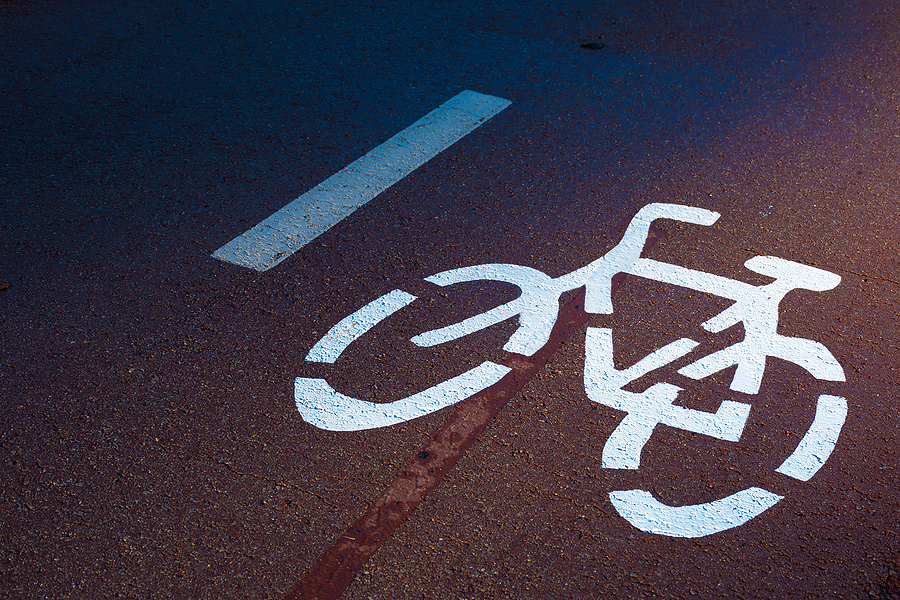
Riding a bike in California is a great way to get around, get some exercise, and protect the environment. However, to bike safely, you need to know California bicycle laws and how they apply to you. Is it illegal to ride your bike on the sidewalk in California? How much room do motorized vehicles have to give you when passing your bike in California? What are some of the most common bicycle accident injuries, and what right do you have to receive compensation for them?
Here are some of California’s important bike laws and how they may impact you on the road.
1. If you have a bike lane available, and you travel slower than the other vehicles around you, you need to use the bike lane.
Many California streets feature bike lanes set aside for cyclists, where you can move at your own pace and remain out of the flow of motorized traffic. They’re a great alternative to riding on the road, which can heighten your risk of getting hurt in a dangerous collision. By riding in the bike lane, you can move at your own pace and stay safe, while not impeding the flow of cars and trucks.
For that reason, when you have an accessible bike lane on the route you have chosen to travel, and you plan to ride at a pace that’s slower than motorized traffic, California law says that you must use the bike lane rather than riding in the road.
If, however, you plan to ride your bike at the same speed as motorized traffic flowing in the same direction, then you do not have to use the bike lane if you don’t want to.
Finally, all cyclists have the right to leave a bike lane if they need to avoid debris or hazards, or to make a left or right-hand turn, so long as they do so safely and following generally applicable traffic laws.
2. You cannot stop or park your bike in a bike lane.
Bike lanes and paths often contain only enough room for one bicycle with safe passing room around it. To keep those lanes safe for all cyclists, you cannot stop or park your bike in a way that will impede or block the flow of other bicyclists around you. While, of course, you may make brief stops to check the safety of your equipment, make deliveries, or engage in other necessary tasks while out on the road, you must always take care not to leave your bike in a manner that obstructs the flow of any kind of traffic, bicycle or motorized.
Most motorized vehicles also cannot stop or park in bike lanes. Utility vehicles, garbage trucks, and official vehicles may do so, but only for as long as necessary to serve their function. Bike lanes are meant for bicyclists in California, and for the most part, they must remain free of vehicles and obstructions.
3. Can you ride your bike on the sidewalk in California? That depends.
California state law leaves the decision about the legality of bicycles on sidewalks up to local governments. Before riding your bike on any sidewalk in California, check out local laws and ordinances to learn what’s legal, and what isn’t.
Most California cities that have adopted bicycle laws restrict or prohibit sidewalk riding in some manner, to ensure pedestrian safety. If you haven’t had the chance to check out local laws in the area you plan to ride, it’s usually safest to assume that you are not allowed to ride on a city sidewalk. If you must ride on a sidewalk for safety or practical reasons, be sure to go slowly and exercise extreme caution around pedestrians. Better yet, get off your bike and walk it until you can once again ride on the road or in a designated bike lane.
4. Anyone under the age of eighteen must wear a helmet when operating a bicycle on streets, bikeways, sidewalks, or public bike paths.
While the law does not require riders over the age of eighteen to wear a helmet, moreover, all bicycle riders should carefully consider the consequences of failing to wear a helmet in the event of an accident. Bicycle helmet use can substantially reduce the risk of traumatic brain injury and facial injuries in a collision. It can also reduce the risk of death in a bicycle accident by as much as 34 percent.
We strongly encourage you to always wear your bicycle helmet and any other safety gear when you ride your bicycle, no matter where your bike trip takes you. Bike helmets are relatively inexpensive, lightweight, and (believe it or not) reasonably stylish. There’s no drawback, and a world of benefit, to wearing one whenever you take to the road on two wheels.
5. California law requires lights and reflectors when driving at night or during times of low visibility.
Lights and reflectors make a bicyclist visible to drivers, especially in visibility-impairing conditions like dusk, fog, and glare. That enhanced visibility reduces the risk of a bicycle accident.
According to California law, bike riders must have:
- A white light at the front of the bicycle or on the cyclist
- A red reflector, potentially including a solid or flashing red light, at the rear
- Yellow and white reflectors on the bike’s pedals or the cyclist’s ankles and shoes
- Yellow and white reflectors at the front part of the bike, or white or red reflectors on the rear end of the bicycle
While installing reflectors on your bicycle may seem like a trivial inconvenience, those reflectors just might save your life. Your bike does not fit the same visual profile as a passenger vehicle, which means that even in areas of California where bikers commonly ride, drivers may not think to look for you. Reflectors help draw attention and cut through low light and haze, thereby making you visible to motorists when you most need them to see you.
6. You need a well-fitted, well-maintained bike.
California law also seeks to ensure that you only ride a safe bicycle that fits your body well. For example:
- Handlebar height: handlebars cannot sit above the height of the cyclist’s shoulders, since too-high handlebars make it difficult to steer safely.
- Seat/frame height: a cyclist should be able to stop and put a foot on the ground without leaning the bike sideways, and should be able to begin pedaling again without losing balance.
- Seat stability: a bicycle should have a permanent, stable seat unless the bike’s specific design does not require one
You can find lots of resources online or in your community (local bike shops, in particular) to learn how to fit and maintain your bicycle.
7. Cyclists cannot ride on certain roads or in certain areas.
Local authorities have the right to prohibit bicycle use on expressways and freeways, and most do. These roads usually do not have bike paths or safe passing areas for bicycles. Biking on them puts cyclists at serious risk of injury and heightens the risk of motor vehicle accidents. Furthermore, cyclists cannot cross toll bridges unless specifically allowed by the California Department of Transportation.
Make sure you know where you can safely ride your bicycle, and plan your route ahead of time to avoid areas where bicycle riding is illegal. CalBike, the California Bicycle Coalition’s website, offers a comprehensive listing of bike Maps & Routes for riders throughout California. You can also find extensive information about California roads—including travel restrictions, traffic conditions, and construction closures—on the CalTrans QuickMap website.
8. Motorists must leave at least three feet of clearance when passing a bicycle.
Many cyclists have had the harrowing experience of getting passed by a motor vehicle at a dangerously close distance. The air turbulence from a fast-moving car or truck can throw a biker off balance, or prompt evasive action that leads to a crash. If a driver misjudges the distance, a motor vehicle can even clip a bicycle, leading to a catastrophic accident.
California law mandates that motorists leave at least three feet of clearance when passing a bicycle. In areas where motorists do not have sufficient clearance, they must slow down behind the cyclist and wait until they have enough room to pass safely. The rule applies equally to bicycles in bike lanes and motor vehicle travel lanes.
Cyclists should also pay careful attention to share the road responsibly and respectfully. If you notice traffic starting to line up behind you, or drivers behind you who seem to be in a rush, especially if this happens on a stretch of road without adequate passing room, move over or move off the road to allow the drivers of passenger vehicles to get around you safely. It’s better for everyone that you stay safe.
9. If you suffer injuries in a bicycle accident, you may have grounds for a personal injury claim.
Bicycle accidents can result in catastrophic injuries, including brain trauma, spinal cord injuries, severe road rash, and broken bones. Even a seemingly minor collision with a motor vehicle can inflict serious, life-altering injuries to cyclists.
Cyclists harmed by accidents caused by someone else’s wrongful conduct have the right, under California law, to seek compensation for their injuries and losses.
You may claim damages for bike accident injuries, for example, if:
- A careless or reckless motorist collides with you or causes you to wreck your bike when passing or following too close, refusing to honor your right to occupy a travel lane, opening the door of a parked vehicle directly into your path, or failing to yield the right of way to you.
- A city government fails to design, construct, or maintain safe travel ways for bicyclists, such as by failing to repair potholes in bike lanes or failing to warn cyclists about dangerous intersections or stretches of road.
- A bicycle manufacturer that sells you a defective bicycle that breaks down under normal operating conditions, causing you to wreck and get hurt.
These are just a few examples.
The point is that anyone whose dangerous decisions or actions contribute to the cause of a bike accident that injures you may owe you damages to pay for:
- Medical expenses associated with treating bike accident injuries, including costs of emergency care, hospitalization, physical therapy, and medication.
- Other expenses caused by the accident and your injuries, such as the cost of replacing your damaged bicycle, or of hiring someone to help you get around while you heal.
- Any wages or income you lose because of your bicycle accident injuries.
- Your physical pain, emotional suffering, and loss of enjoyment of life stemming from the injuries you suffered.
The most reliable way to obtain compensation for bicycle accident injuries in California is to hire an experienced bicycle accident injury lawyer to represent you, and to do so as soon as possible after you get hurt. An attorney will represent your interests above all others and fight to get you as much money as possible from anyone whose wrongful actions harmed you. The sooner you contact a skilled lawyer, the better your chances of obtaining the compensation you deserve, and the lower the risk of missing an important deadline that may short-circuit your legal rights. For example, if you wait too long, your claim may be barred by a statute of limitations.
To learn more about obtaining compensation for your injuries in the wake of a California bicycle accident, contact an experienced attorney as soon as possible. Your initial consultation with a skilled lawyer is always free of charge, and most California bicycle accident lawyers represent their clients on contingency, meaning they only get paid if they get you results.







